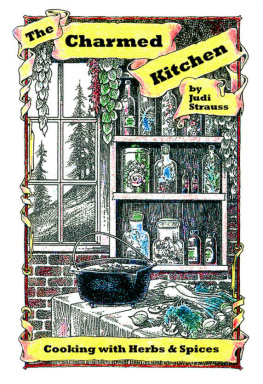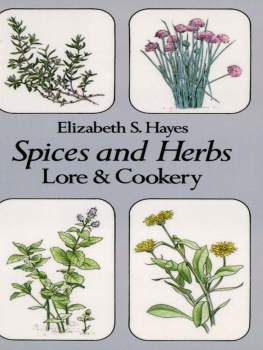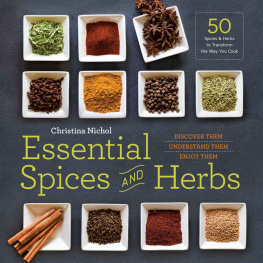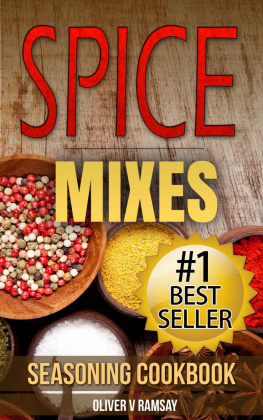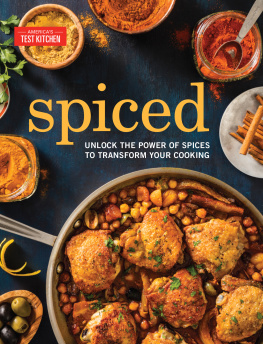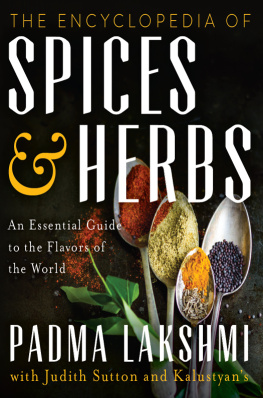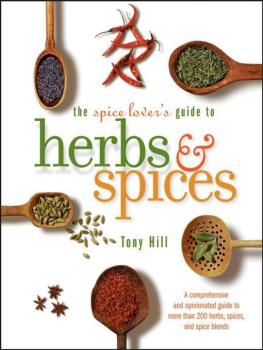Judi Strauss - The Charmed Kitchen: Cooking with Herbs & Spices
Here you can read online Judi Strauss - The Charmed Kitchen: Cooking with Herbs & Spices full text of the book (entire story) in english for free. Download pdf and epub, get meaning, cover and reviews about this ebook. year: 2015, publisher: ATBOSH Media Ltd., genre: Home and family. Description of the work, (preface) as well as reviews are available. Best literature library LitArk.com created for fans of good reading and offers a wide selection of genres:
Romance novel
Science fiction
Adventure
Detective
Science
History
Home and family
Prose
Art
Politics
Computer
Non-fiction
Religion
Business
Children
Humor
Choose a favorite category and find really read worthwhile books. Enjoy immersion in the world of imagination, feel the emotions of the characters or learn something new for yourself, make an fascinating discovery.
- Book:The Charmed Kitchen: Cooking with Herbs & Spices
- Author:
- Publisher:ATBOSH Media Ltd.
- Genre:
- Year:2015
- Rating:3 / 5
- Favourites:Add to favourites
- Your mark:
- 60
- 1
- 2
- 3
- 4
- 5
The Charmed Kitchen: Cooking with Herbs & Spices: summary, description and annotation
We offer to read an annotation, description, summary or preface (depends on what the author of the book "The Charmed Kitchen: Cooking with Herbs & Spices" wrote himself). If you haven't found the necessary information about the book — write in the comments, we will try to find it.
The Charmed Kitchen: Cooking with Herbs & Spices — read online for free the complete book (whole text) full work
Below is the text of the book, divided by pages. System saving the place of the last page read, allows you to conveniently read the book "The Charmed Kitchen: Cooking with Herbs & Spices" online for free, without having to search again every time where you left off. Put a bookmark, and you can go to the page where you finished reading at any time.
Font size:
Interval:
Bookmark:
The Charmed Kitche n Cooking with Herbs & Spices by Judi Strauss Second Edition Copyright 1996, 2015 by Judi Strauss Published by ATBOSH Media ltd. Cleveland, Ohio, USA  www.atbosh.com Table of Contents Chapter 1: Getting Started: How to Use This Book If your idea of cooking with herbs and spices has been to use a sprinkling of parsley now and then, or maybe a dash of seasoned salt now is the time to expand your horizons. Cooking. really cooking. with herbs and spices makes an ordinary dish extraordinary. I am a person who grows herbs and cooks with them and I am always trying new combinations to add interest to my dishes.
www.atbosh.com Table of Contents Chapter 1: Getting Started: How to Use This Book If your idea of cooking with herbs and spices has been to use a sprinkling of parsley now and then, or maybe a dash of seasoned salt now is the time to expand your horizons. Cooking. really cooking. with herbs and spices makes an ordinary dish extraordinary. I am a person who grows herbs and cooks with them and I am always trying new combinations to add interest to my dishes.
Through the years I have found few limits to the ways I can use herbs and spices in the kitchen. As an added bonus I find that, without sacrificing taste, I dont need to use as much salt. So if herbs and spices are so useful, why dont people use more of them when they cook? In my classes many of my students have expressed a certain fear of herbs. They find using herbs as intimidating as choosing the right wine to go with dinner. I hope that if I accomplish one thing with this book it is to change that fear into action and use. In order to overcome this fear all you need a sense of adventure and some fresh, frozen or dried herbs and spices.
There are use charts in this book to assist you in choosing which herbs to use with which foods but dont be limited by what any chart says, including mine. If you discover an herb whose flavor you prefer I urge you to try it on different dishes. Experiment! Live dangerously! Begin with herbs you are familiar with and then branch out to unfamiliar herbs. After some practice youll find that using herbs and spices is as natural as adding salt and pepper. Once you learn the taste of different herbs and spices you will discover your likes and dislikes. Along the way you are sure to find some new favorites.
An experienced cook knows how to use a light hand with herbs. You dont want to overpower your food. You are trying to enhance taste through the addition of new flavors, a layering of flavors. Vary recipes to your preferences and dont limit yourself. One of the hardest parts of writing this book was measuring as I cooked so I could write my recipes to standards that anyone could follow. Truth be known I rarely follow recipes exactly.
That is just the way I cook. As you work with this book open yourself up to new and creative tastes and have a good time! Chapter 2: An Alphabetical Listing of Herbs and Spices This listing is meant to serve as a guide to using specific herbs and spices when you cook. This does not mean that you should feel limited to only what is listed here. Over centuries of use certain herbs and spices just seem to pair up well with certain foods. Allspice This is one of the most popular spices used in American kitchens today in baking, particularly in apple and pumpkin pies. Allspice tastes like a combination of cinnamon, cloves and nutmeg.
It goes well with beef dishes, particularly stews, and is sometimes used in vegetable dishes. Allspice is great with tomato dishes and in pickling. It is also used widely in the cuisines of the Middle East, North Africa and Asia. Anise Anise has the taste of licorice. It is used in baking, mostly for cookies. Anise seeds can also be used in place of fennel seeds in dishes such as Italian sausages and spaghetti sauce.
Anise seeds are used to flavor the liqueur Anisette. A few anise seeds can be ground up with coffee beans or added to ground coffee to make licorice-flavored coffee. Basil Just about any main dish is improved with the addition of basil. It is the essential ingredient in classic pesto sauce. Basil is a sweet-flavored herb used widely in Italian cuisine. It complements the flavor of tomato dishes and well as other vegetables.
It goes well with beef and chicken dishes and in soups and salad dressings. The large-leaf variety can be used almost like a lettuce wrap, delicately wrapped around a filling. Basil comes in a wide assortment of varieties and flavors. There is lemon basil, which is great with chicken and seafood and even in tea. Cinnamon basil works well with Indian and other Asian cuisines. Cinnamon basil is wonderful with meat dishes.
Thai basil, as expected is used with Asian dishes-but can be used in everything from salad dressing to red sauces. Bay Leaf Also called Sweet Bay. The flavor of bay leaf is a combination of both sweet and a little spicy. It is most often added to soup, especially chicken soup. It goes well with a wide array of foods including meats, fishes and vegetables. Bay is often used in pickles.
It also goes well with recipes using dried beans, like baked beans or bean soups. When you toss that bay leaf into the pot be sure to fish it out later! Bay leaf stays tough and someone could choke on it. Bay leaves can also be tied into cheesecloth or put in a tea ball with other herbs and spices for easier removal later. Bergamot Also known as bee balm and Monarda, this member of the mint family has a light orange flavor and is used in herb teas and fruit salads. Petals of the flowers are also edible and make a decorative addition to salads, dips and pasta dishes. Borage Leaves taste like cucumber and can be eaten in salads.
Older leaves get tough, so use young leaves. Borage flowers are blue, pink or lavender and are edible. They make a pretty addition to salads, soups or most any food. Caraway Probably best known as an addition to rye bread. Caraway seeds can also be used on crackers, blended into cheeses, with sauerkraut and with carrots and potatoes. The seeds are also used to flavor the liqueur Akavit.
According to tradition, it is drunk, ice cold, at midnight on New Year's Eve for good luck in the New Year. Cardamom Seeds are ground into a powder used to flavor breads, cakes cookies and other baked goods. Cardamom has a rich sweet flavor and fragrance used by Scandinavians. Cardamom is more expensive than most other spices. To keep it longer store in the fridge or freezer. As with other spices, buying the seed pods and grinding your own will result in stronger flavor than pre-ground.
Cardamom also adds a nice flavor to frostings and glazes. Also used to flavor coffee. Cayenne Pepper Cayenne, commonly referred to as red pepper, is not a peppercorn in the way that black pepper is a peppercorn bud. Cayenne is the dried seeds and fruit of a variety of vegetable pepper. This is a very hot seasoning used in many cuisines. It is essential in Cajun and Creole cooking.
It is hotter than black pepper so use with caution. It also used widely in Italian and Mexican cooking. Like other red spices cayenne pepper should be stored in the refrigerator to retain its flavor. Celery Leaves Dried or fresh celery leaves add a wonderful flavor to soups stocks and stews. Also makes a nice addition to salad dressings and vegetable dips. Add to marinades for meat or fish.
Fresh leaves can be chopped and added to salads. (See also Lovage) Celery Seeds Pungent tasty seeds are used to flavor salads, salad dressings, vegetable dishes, fish, dips, soups and stews. These seeds taste particularly good with tomatoes and in cabbage dishes. They make a nice addition to coleslaw or sweet and sour cabbage. (See also Lovage) Chamomile Flowers from this herb are used to make a soothing herbal teas. They can be used fresh or dried.
Flowers can also be used to decorate a salad plate, dips or fruit plates. Chervil Chervil is sometimes called French parsley. Used like parsley, but chervil is more pungent. The spicier flavor is very appealing. Chervil does not hold its flavor when dried, however, and is best used fresh or frozen. It does not require a lot of sunlight, so you can grow a pot on most any windowsill.
Next pageFont size:
Interval:
Bookmark:
Similar books «The Charmed Kitchen: Cooking with Herbs & Spices»
Look at similar books to The Charmed Kitchen: Cooking with Herbs & Spices. We have selected literature similar in name and meaning in the hope of providing readers with more options to find new, interesting, not yet read works.
Discussion, reviews of the book The Charmed Kitchen: Cooking with Herbs & Spices and just readers' own opinions. Leave your comments, write what you think about the work, its meaning or the main characters. Specify what exactly you liked and what you didn't like, and why you think so.

